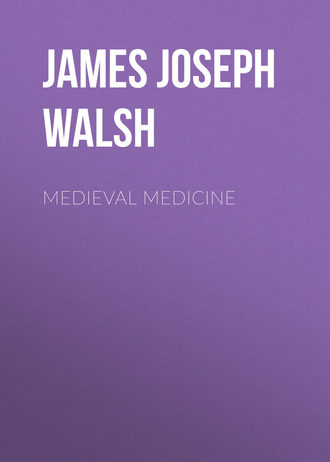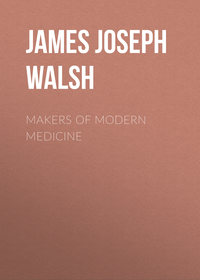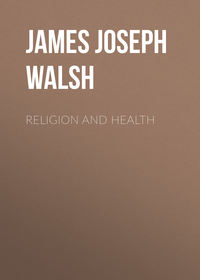 полная версия
полная версияMedieval Medicine
Galen, after Aristotle, was the author oftenest quoted in the Middle Ages, and most revered. Anyone who wants to understand this medieval reverence needs only to read Galen. There has probably never been a greater clinical observer in all the world than this Greek from Pergamos, whose works were destined to have so much influence for a millennium and a half after his time. How well he deserved this prestige only a careful study of his writings will reveal. It is simply marvellous what he had seen and writes about. Anatomy, physiology, pathological anatomy, diagnosis, therapeutics—all these were magnificently developed under his hands, and he has left a record of accurate and detailed observation. There are many absurdities easily to be seen in his writings now, but no one has yet written on medicine in any large way who has avoided absurdities, nor can anyone hope to, until we know much more of the medical sciences than at present. The therapeutics of any generation is always absurd to the second succeeding generation, it has been said. Those in the modern time who know their Galen best have almost as much admiration for him, in spite of all our advance in the knowledge of medicine, as the medieval people had. No wonder, seeing the depth and breadth of his knowledge, that he was thought so much of, and that men hesitated to contravene anything that he said.
Even in the authorities to which they turned with so much confidence, the medieval physicians are admirable. If man must depend on authority, then he could not have better than they had. As with regard to this, so in all other matters relating to the Middle Ages, the ordinarily accepted notions prove to have been founded on ignorance of actual details, and misconceptions as to the true significance of their point of view. To have contempt give way to admiration, we need only to know the realities even in such meagre details as can be given in a short manual of this kind. The thousand years of the Middle Ages are now seen to have been full of interesting and successful efforts in every mode of human activity, and medicine and surgery shared in this to the full.
CHAPTER II
EARLY MEDIEVAL MEDICINE
There are two distinct periods in the history of Medieval Medicine. The first concerns the early centuries, from the sixth to the ninth, and is occupied mainly with the contributions to medicine made by those who were still in touch with the old Greek writers; while the second represents the early Renaissance, when the knowledge of the Greek writers was gradually filtering back again, sometimes through the uncertain channel of the Arabic. Both periods contain contributions to medicine that are well worthy of consideration, and nearly always the writings that have been preserved for us demonstrate the fact that men were thinking for themselves as well as studying the Greek writers, and were making observations and garnering significant personal experience. The later Middle Ages particularly present material in this regard of far greater interest than was presumed to exist until comparatively recent historical studies were completed.
The real history of medicine in the Middle Ages—that is, of scientific medicine—is eclipsed by the story of popular medicine. So much has been said of the medical superstitions, many of which were rather striking, that comparatively little space has been left for the serious medical science and practice of the time, which contain many extremely interesting details. It is true that after the Crusades mummy was a favourite pharmacon, sometimes even in the hands of regular physicians; and Usnea, the moss from the skulls of the bodies of criminals that had been hanged and exposed in chains, was declared by many to be a sovereign remedy for many different ills; but it must not be forgotten that both of these substances continued to be used long after the medieval period, mummy even down to the middle of the eighteenth century, and Usnea almost as late. Indeed, it is probable that the seventeenth and eighteenth centuries present many more absurdities in therapeutics than do the later centuries of the Middle Ages. In this, as in so many other regards, the modern use of the adjective medieval has been symbolic of ignorance of the time rather than representative of realities in history.
Popular medicine is always ridiculous, though its dicta are often accepted by supposedly educated people. This has always been true, however, and was never more true than in our own time, when the vagaries of medical faddism are so strikingly illustrated, and immense sums of money spent every year in the advertising of proprietary remedies, whose virtues are often sadly exaggerated, and whose tendency to work harm rather than good is thoroughly appreciated by all who know anything about medicine. The therapeutics of supposedly scientific medicine are often dubious enough. A distinguished French professor of physiology quoted, not long since, with approval, that characteristic French expression: “The therapeutics of any generation are always absurd to the second succeeding generation.” When we look back on the abuse of calomel and venesection a century ago, and of the coal-tar derivatives a generation ago, and the overweening confidence in serums and vaccines almost in our own day, it is easy to understand that this law is still true. We can only hope that our generation will not be judged seven centuries from now by the remedies that were accepted for a time, and then proved to be either utterly ineffectual or even perhaps harmful to the patients to whom they were given.
When we turn our attention away from this popular pseudo-history of Medieval Medicine, which has unfortunately led so many even well-informed persons into entirely wrong notions with regard to medical progress during an important period, we find much that is of enduring interest. The first documents that we have in the genuine history of Medieval Medicine, after the references to the organizations of Christian hospitals at Rome and Asia Minor in the fourth and fifth centuries (see chapter Medieval Hospitals), are to be found in the directions provided in the rules of the religious orders for the care of the ailing. St. Benedict (480-543), the founder of the monks of the West, was particularly insistent on the thorough performance of this duty. The rule he wrote to guide his religious is famous in history as a great constitution of democracy, and none of its provisions are more significant than those which relate to the care of the health of members of the community.
One of the rules of St. Benedict required the Abbot to provide in the monastery an infirmary for the ailing, and to organize particular care of them as a special Christian duty. The wording of the rule in this regard is very emphatic. “The care of the sick is to be placed above and before every other duty, as if, indeed, Christ were being directly served in waiting on them. It must be the peculiar care of the Abbot that they suffer from no negligence. The Infirmarian must be thoroughly reliable, known for his piety and diligence and solicitude for his charge.” The last words of the rule are characteristic of Benedict’s appreciation of cleanliness as a religious duty, though doubtless also the curative effect of water was in mind. “Let baths be provided for the sick as often as they need them.” As to what the religious infirmarians knew of medicine, at least as regards the sources of their knowledge and the authors they were supposed to have read, we have more definite information from the next historical document, that concerning medical matters in the religious foundation of Cassiodorus.
Cassiodorus (468-560), who had been the prime minister of the Ostrogoth Emperors, when he resigned his dignities and established his monastery at Scillace in Calabria, was influenced deeply by St. Benedict, and was visited by the saint not long after the foundation.
His rule was founded on that of the Benedictines. Like that, it insisted especially on the care of the sick, and the necessity for the deep study of medicine on the part of those who cared for them. Cassiodorus laid down the law in this regard as follows: “I insist, brothers, that those who treat the health of the body of the brethren who have come into the sacred places from the world should fulfil their duties with exemplary piety. Let them be sad with others’ suffering, sorrowful over others’ dangers, sympathetic to the grief of those whom they have to care for, and always ready zealously to help others’ misfortunes. Let them serve with sincere study to help those who are ailing as becomes their knowledge of medicine, and let them look for their reward from Him who can compensate temporal work by eternal wages. Learn, therefore, the nature of herbs, and study diligently the way to combine their various species for human health; but do not place your entire hope on herbs, nor seek to restore health only by human counsels. Since medicine has been created by God, and since it is He who gives back health and restores life, turn to Him. Remember, do all that you do in word or deed in the name of the Lord Jesus, giving thanks to God the Father through Him. And if you are not capable of reading Greek, read above all the translations of the Herbarium of Dioscorides, which describes with surprising exactness the herbs of the field. After this, read translations of Hippocrates and Galen, especially the Therapeutics, and Aurelius Celsus’ ‘De Medicina,’ and Hippocrates’ ‘De Herbis et Curis,’ and divers other books written on the art of medicine, which by God’s help I have been able to provide for you in my library.”
The monasteries are thus seen to have been in touch with Greek medicine from the earliest medieval time. The other important historical documents relating to Medieval Medicine which we possess concern the work of the men born and brought up in Asia Minor, for whom the Greeks were so close as to be living influences. Aëtius, Alexander of Tralles, and Paul of Ægina have each written a series of important chapters on medical subjects, full of interest because the writers knew their Greek classic medicine, and were themselves making important observations. Aëtius, for instance, had a good idea of diphtheria. He speaks of it in connection with other throat manifestations under the heading of “crusty and pestilent ulcers of the tonsils.” He divides the anginas generally into four kinds. The first consists of inflammation of the fauces with the classic symptoms; the second presents no inflammation of the mouth nor of the fauces, but is complicated by a sense of suffocation—apparently our neurotic croup. The third consists of external and internal inflammation of the mouth and throat, extending towards the chin. The fourth is an affection rather of the neck, due to an inflammation of the vertebræ—retropharyngeal abscess—which may be followed by luxation, and is complicated by great difficulty of respiration. All of these have as a common symptom difficulty of swallowing. This is greater in one variety than in another at different times. In certain affections he remarks that even “drinks when taken are returned through the nose.”
Aëtius declares quite positively that all the tumours of the neck region, with the exception of scirrhus, are easily cured, yielding either to surgery or to remedies. The exception is noteworthy. He evidently saw a good many of the functional disturbances and the enlargements of the thyroid gland, which are often so variable in character as apparently to be quite amenable to treatment, and which have actually been “cured” in the history of medicine by all sorts of things from the touch of the hangman’s rope to the wrapping of the shed skin of the snake around the neck. A few cervical tumours were beyond resource. Aëtius suggests the connection between hypertrophy of the clitoris and certain exaggerated manifestations of the sexual instinct, as well as the development of vicious sexual habits.
It requires only a little study of this early medieval author to understand why Cornelius, at the time of the Renaissance, was ready to declare: “Believe me, that whoever is deeply desirous of studying things medical, if he would have the whole of Galen abbreviated and the whole of Orbiasius extended, and the whole of Paulus (of Ægina) amplified; if he would have all the special remedies of the old physicians, as well in pharmacy as in surgery, boiled down to a summa for all affections, he will find it in Aëtius.”
Alexander of Tralles was, as we have said, the brother of the architect of Santa Sophia of Constantinople, and his writings on medical and surgical subjects are worthy of such a relationship. His principal work is a treatise on the “Pathology and Therapeutics of Internal Diseases” in twelve books, the first eleven books of which were evidently material gathered for lectures or teaching purposes. He treats of cough as a symptom due to hot or cold, dry or wet, dyscrasias. Opium preparations judiciously used he thought the best remedies, though he recommended also the breathing in of steam impregnated with various ethereal resins.
He outlines a very interesting because thoroughly modern treatment of consumption. He recommends an abundance of milk with a hearty nutritious diet, as digestible as possible. A good auxiliary to this treatment in his opinion was change of air, a sea voyage, and a stay at a watering-place. Ass’s and mare’s milk are much better for these patients than cow’s and goat’s milk. We realize now that there is not enough difference in the composition of these various milks to make their special prescription of physical importance, but it is probable that the suggestive influence of the taking of an unusual milk had a very favourable effect upon patients, and this effect was renewed with every drink taken, so that much good was ultimately accomplished. For hæmoptysis, especially when it was acute and due, as Alexander felt, to the rupture of a bloodvessel in the lungs, he recommended the opening of a vein at the elbow or the ankle—in order to divert the blood from the place of rupture to the healthy parts of the circulation. He insisted, however, that the patients must in addition rest, as well as take acid and astringent drinks, while cold compresses should be placed upon the chest [our ice-bags], and that they should take only a liquid diet, at most lukewarm, or, better, if agreeable to them, cold. When the bleeding stopped, he declared a milk cure [blood-maker] very useful for the restoration of these patients to their former strength.
He paid particular attention to diseases of the nervous system, and discussed headache at some length. Chronic or recurrent headache he attributed to diseases of the brain, plethora, biliousness, digestive disturbances, insomnia, and prolonged worry. Hemicrania he thought due to the presence of toxic materials, though it was also connected with abdominal disorders, especially in women. Alexander has much to say of the paralytic and epileptic conditions, and recommended massage, rubbings, baths, and warm applications for the former, and emphasized the need for careful directions as to the mode of life, and special attention to the gastro-intestinal tract, in the latter. A plain, simple diet, with regular bowels, he considers the most important basis for any successful treatment of epilepsy. Besides, he recommended baths, sexual abstinence, and regular exercise. He rejected treatment of the condition by surgery of the head, either by trephining or by incisions or by cauterization. His teaching is that of those who have had most experience with the disease in our own time. For sore throat he prescribes gargles or light astringents at the beginning, and stronger astringents, alum and soda dissolved in water, later in the case.
He particularly emphasized that trust should not be placed in any single method of treatment. Every available means of bringing relief to the patient should be tried. “The duty of the physician is to cool what is hot, to warm what is cold, to dry what is moist, and to moisten what is dry. He should look upon the patient as a besieged city, and try to rescue him with every means that art and science placed at his command. The physician should be an inventor, and think out new ways and means by which the cure of the patient’s affection and the relief of his symptoms may be brought about.” The most important factor in Alexander’s therapeutics is his diet. Watering-places and various forms of mineral waters, as well as warm baths and sea baths, are constantly recommended by him. He took strong ground against the use of many drugs, and the rage for operating. The prophylaxis of disease is in Alexander’s opinion the important part of the physician’s duty. His treatment of fever shows the application of his principle: cold baths, cold compresses, and a cooling diet, were his favourite remedies. He encouraged diaphoresis nearly always, and gave wine and stimulating drugs when the patient was very weak.
Some of the general principles of medical practice which Alexander lays down are very significant even from our modern standpoint. He deprecated drastic remedies of all kinds. He did not believe in severe purgation nor in profuse or sudden blood-letting. His diagnosis was thorough and careful. He insisted particularly on inspection and palpation of the whole body; on careful examination of the urine, of the fæces, and the sputum; on study of the pulse and the breathing. He dwelt on the fact that much might be learned from the patient’s history taken carefully. The general constitution was the most important element, in his estimation. His therapeutics is, above all, individual. Remedies must be administered with careful reference to the constitution, the age, the sex, and the condition of the patient’s strength. Special attention must always be paid to seconding nature’s efforts to cure. Alexander had no sympathy at all with the idea that nature was to be disturbed, much less that remedies must work in opposition to natural tendencies to recovery.
Paul of Ægina, educated at the University at Alexandria, probably flourished during the reign of the Emperor Heraclius, who died 641; his works contain more of surgical than of medical interest.
The Arab writer, Abul Farag, to whose references we owe the definite placing of the time when Paul lived, said that “he had special experience in women’s diseases, and had devoted himself to them with great industry and success. The midwives of the time were accustomed to go to him and ask his counsel with regard to accidents that happen during and after parturition. He willingly imparted his information, and told them what they should do. For this reason he came to be known as the Obstetrician.” Perhaps the term should be translated the man-midwife, for it was rather unusual for men to have much knowledge of this subject. His knowledge of the phenomena of menstruation was wide and definite. He knew a great deal of how to treat its disturbances. He seems to have been the first one to suggest that in metrorrhagia, with severe hæmorrhage from the uterus, the bleeding might be stopped by putting ligatures around the limbs. This same method has been suggested for severe hæmorrhage from the lungs as well as from the uterus in our own time. In hysteria he also suggested ligature of the limbs, and it is easy to understand that this might be a very strongly suggestive treatment for the severer forms of hysteria. It is possible, too, that the modification of the circulation to the nervous system induced by the shutting off of the circulation in large areas of the body might very well have a favourable physical effect in this affection. Paul’s description of the use of the speculum is as complete as that in any modern textbook of gynæcology.
In the chapter on the medieval care of the insane, there are some clinical observations and suggestions as to treatment from Paul which make it very clear what a careful observer he was, and how rational in his application of such knowledge as he had to the treatment of patients. Probably his contributions to the difficult subject psychiatry, well above a thousand years ago, will serve to make his genius as a physician clearer than almost anything else that could be said of him.
Among the great Arabian physicians who represent the transition period, from the earlier Middle Ages directly under Greek influence, still surviving to the later Middle Ages, when the earlier Renaissance brought back the Greek masters once more, were Rhazes, Ali Abbas, Avicenna—whose name had been transformed from the Arabic Ibn Sina—Abulcasis, Avenzoar, and Averroes, the last named a philosophic theorist but not a physician. The first three named were born in the East, the last three in Spain. Besides these Maimonides, the great Jewish physician, who was born and educated at Cordova in Spain, deserves a place. In this earlier period Rhazes must be mentioned, while the others who merit special attention will be considered in the chapter on Later Medieval Medicine.
Rhazes (died 932) is one of the great epoch-makers in the history of medicine. He was the first to give us a clear description of smallpox. Some of his medical aphorisms are well worth noting, and make it very clear that he was a careful observer.
“When you can heal by diet, prescribe no other remedy; and where simple remedies suffice, do not take complicated ones.”
Rhazes knew well the value of the influence of mind over body even in serious organic disease, and even though death seemed impending. One of his aphorisms is: “Physicians ought to console their patients even if the signs of impending death seem to be present.” He considered the most valuable thing for the physician to do was to increase the patient’s natural vitality. Hence his advice: “In treating a patient, let your first thought be to strengthen his natural vitality. If you strengthen that, you remove ever so many ills without more ado. If you weaken it, however, by the remedies that you use, you always work harm.” The simpler the means by which the patient’s cure can be brought about, the better in his opinion. He insists again and again on diet rather than artificial remedies. “It is good for the physician that he should be able to cure disease by means of diet, if possible, rather than by means of medicine.” Another of his aphorisms seems worth while quoting: “The patient who consults a great many physicians is likely to have a very confused state of mind.”
During the ninth and tenth centuries the Arabs continued to be the most important contributors to medicine, until the rise of the school at Salerno gave a new impetus to clinical observation, and furnished a new focus of medical attention in the West. Constantine brought whatever of Arab influence there was in Salerno, as we have pointed out in the chapter on the Beginnings of Medical Education; but after his time there is an originality about Salernitan medicine which makes it of great value as the foster-mother of the sciences related to medicine during the later Middle Ages.
CHAPTER III
SALERNO AND THE BEGINNINGS OF MODERN MEDICAL EDUCATION
The first medical school of modern history, and the institution which more than any other has helped us to understand the Middle Ages, is that of Salerno. Indeed, the accumulation of information with regard to this medical school, formally organized in the tenth century but founded a century earlier, and reaching a magnificent climax of development at the end of the twelfth century, has done more than anything else to revolutionize our ideas with regard to medieval education and the scientific interests of the Middle Ages. We owe this development of knowledge to De Renzi, whose researches with regard to matters Salernitan, and medical education generally in Italy in the Middle Ages, are well deserving of the prestige that has been at length accorded them.
In his “Storia della Medicina in Italia,” published so modestly at Naples, the patient Italian student of medical history made an epoch-making contribution to the history of medicine. Unless one has actually read his book, it is difficult to understand how deep our obligations to him are. Anyone who might be tempted to think that medicine was not taken seriously, or that careful clinical observations and serious experiments for the cure of disease were not made at Salerno, will be amply undeceived by a reading of De Renzi. Above all, he makes it very clear that medical education was taken up with rigorous attention to details and high standards maintained. Three years of college work were demanded in preparation for medical studies, and then four years at medicine, followed by a year of practice with a physician, and even an additional year of special study in anatomy, had to be taken, if surgery were to be practised. All this before the licence to practise medicine was given; though the degree of doctor, granting the privilege of teaching as the word indicates, was conferred apparently after the completion of the four years at the medical school. We have had to climb back to these medieval standards of medical education in many countries in recent years, after a period of deterioration in which often the requirements for the physician’s training for practice were ever so much lower.











